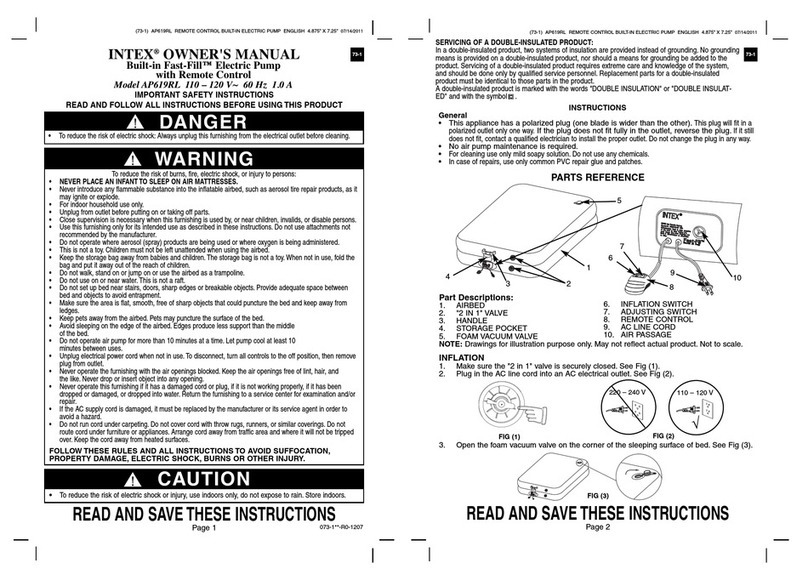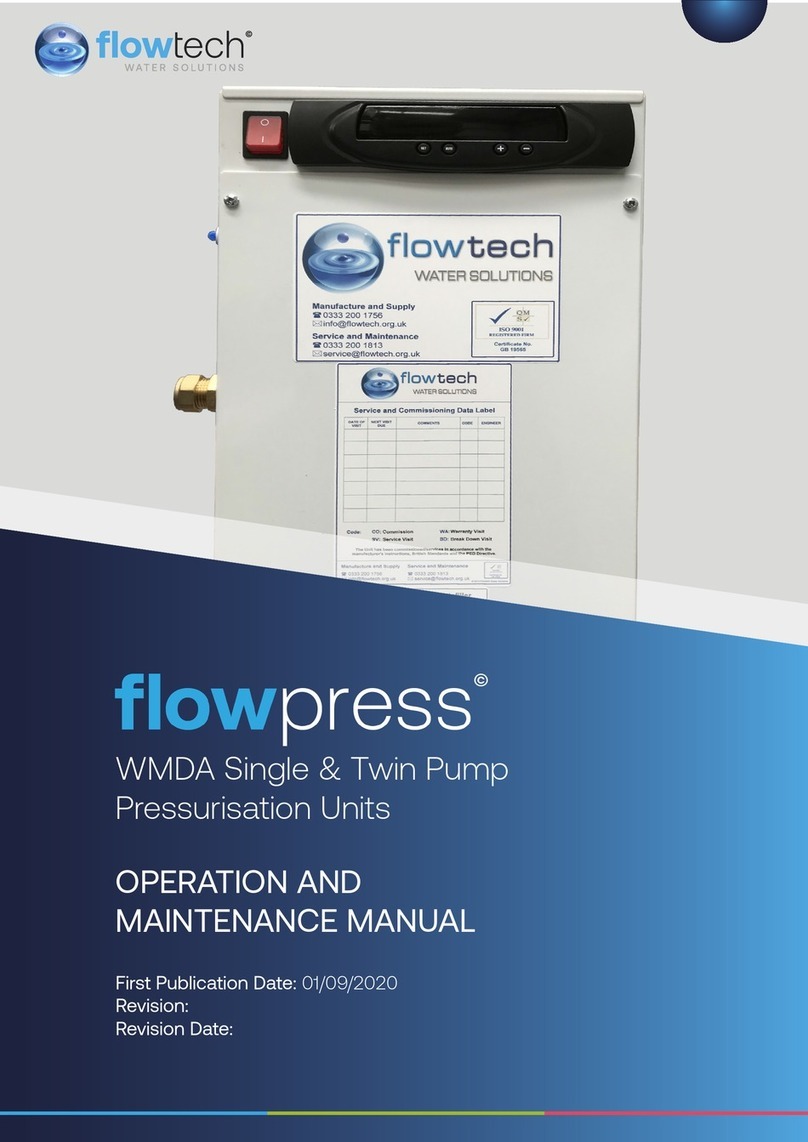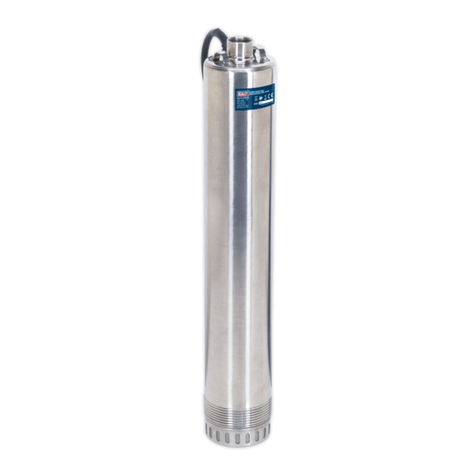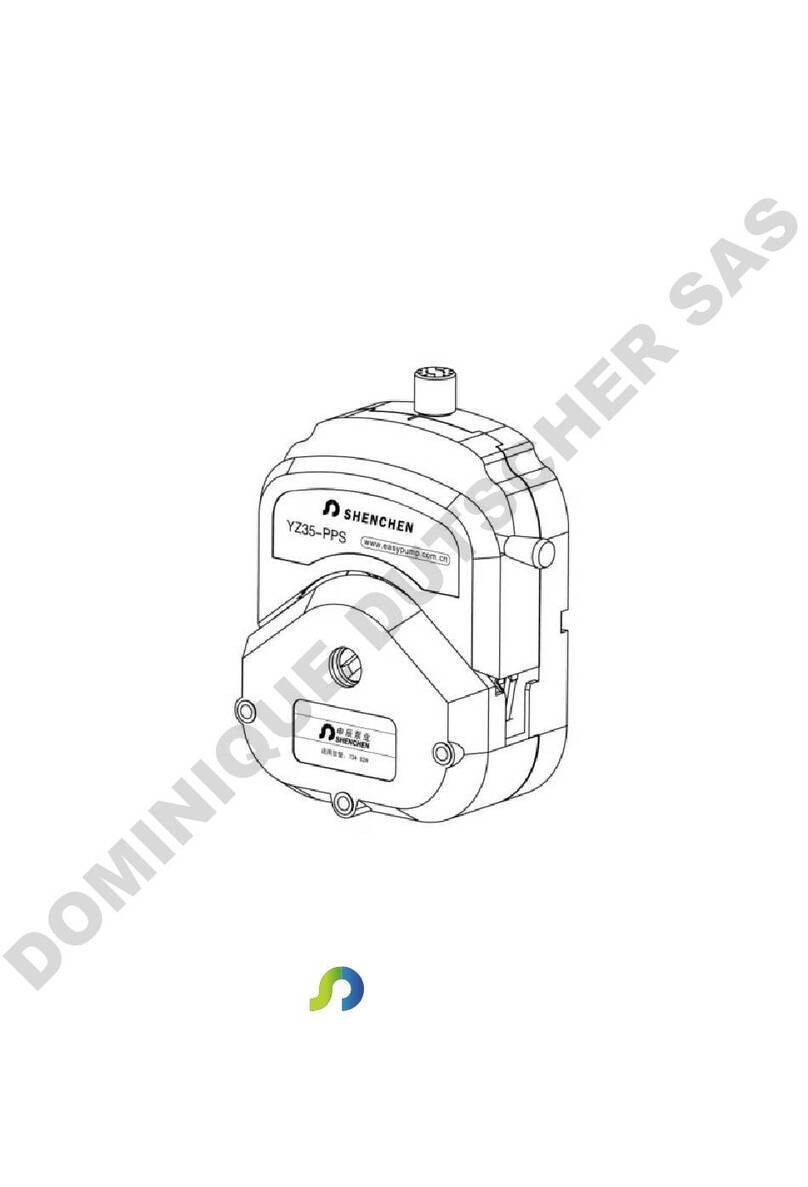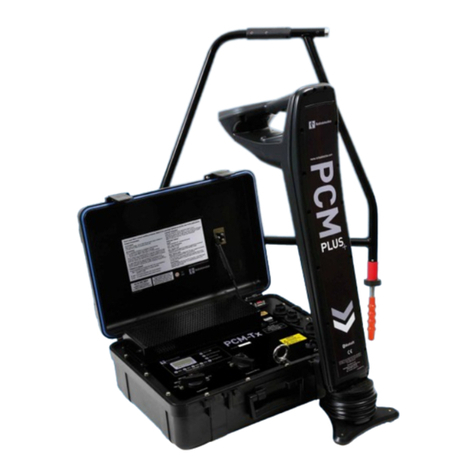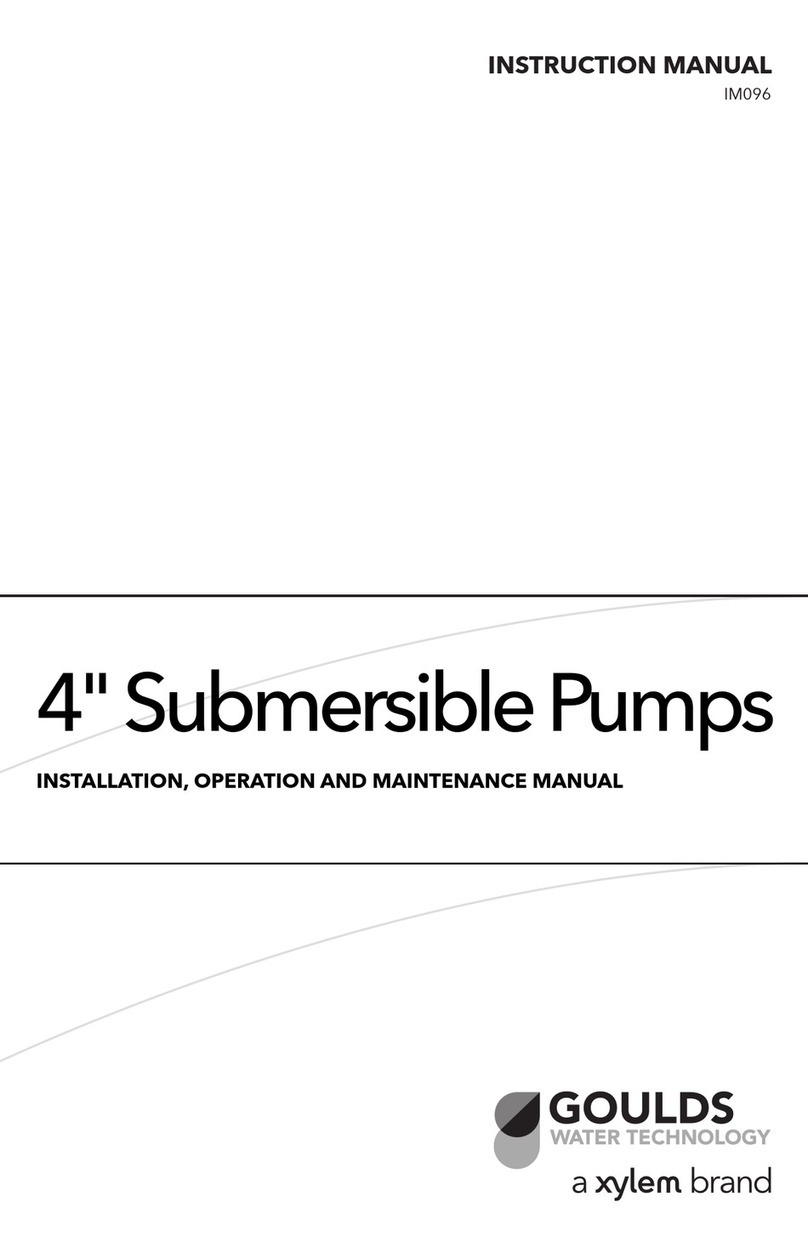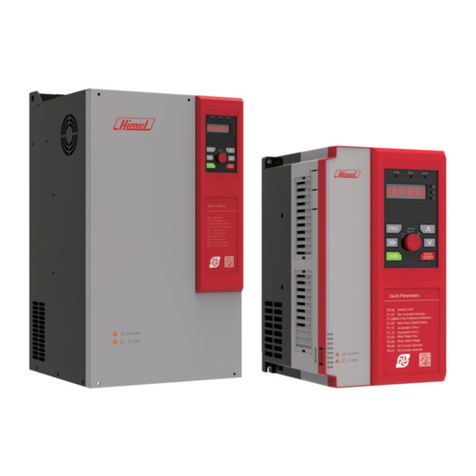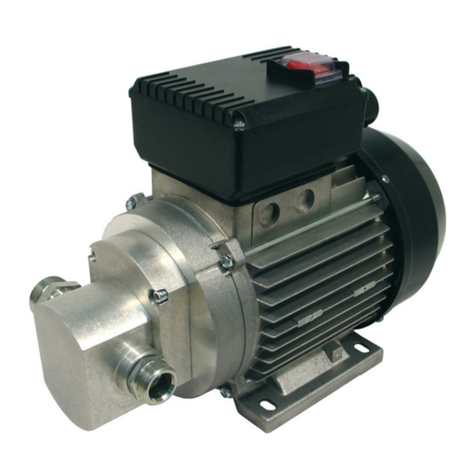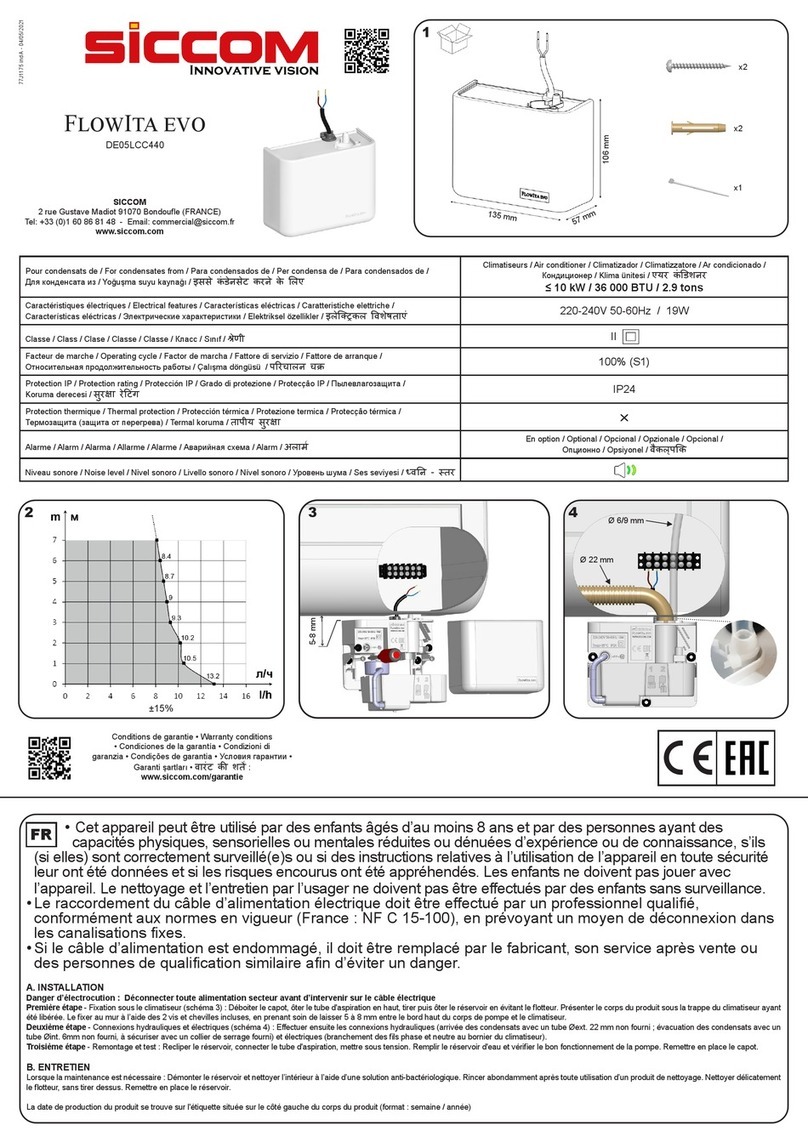Spencer RES-Q-VAC User manual

User’s Manual
RES-Q-VAC – Manual suction pump EN
Guarantee of Quality system for the production and the inal control of the products
certiied by the notifying body TÜV SÜD Product Service GMBH
This appliance conforms
with the Directive 93/42/CEE
“Medical Devices”
0123
SPENCER ITALIA SRLSPENCER ITALIA SRL – Via Provinciale n° 12
43038 Sala Baganza (PR) – Italy
IT
Manuale d’Uso e Manutenzione
RES-Q-VAC – Aspiratore di secreti manuale
Sistema di Garanzia di Qualità per la produzione ed il controllo inale dei
prodotti certiicato dall’organismo notiicato TÜV SÜD Product Service GMBH
Si dichiara che il dispositivo è
conforme alla Direttiva 93/42/CEE
“Dispositivi Medici”
0123
DE
Benutzerhandbuch
RES-Q-VAC – Manuelle Absaugpumpe
Garantie des Qualitätssystems für die Produktion und die Endkontrolle
der Produkte, zertiiziert durch TÜV SÜD Product Service GmbH als
Benannte Stelle.
Dieses Gerät entspricht den einschlägigen
Bestimmungen der Richtlinie 93/42/EWG für
Medizinprodukte
0123

2
INDICE / CONTENTS / INHALTSVERZEICHNIS
INFORMAZIONI GENERALI 2
AVVERTENZE 2
DESCRIZIONE DEL PRODOTTO 2
ISTRUZIONI OPERATIVE 3
MANUTENZIONE E PULIZIA 4
ACCESSORI E RICAMBI 4
GENERAL INFORMATION 6
WARNINGS 6
DESCRIPTION OF PRODUCT 6
OPERATING INSTRUCTIONS 7
MAINTENANCE AND CLEANING 8
ACCESSORIES AND SPARE PARTS 8
ALLGEMEINE ANGABEN 2
WARNHINWEISE 2
PRODUKTBESCHREIBUNG 3
BEDIENUNGSANWEISUNGEN 3
INSTANDHALTUNG UND REINIGUNG 4
EXTERNES ZUBEHÖR UND ERSATZTEILE 5
DE
EN
IT

3
IT
EN
DE
1 INFORMAZIONI GENERALI
1.1 SCOPO E CONTENUTO
Questo manuale ha lo scopo di fornire al Cliente tutte le informazioni necessarie affinchè, oltre ad un adeguato utilizzo del dispositivo, sia in
grado di gestire lo strumento nel modo più autonomo e sicuro possibile. Esso comprende informazioni inerenti l'aspetto Tecnico, il
Funzionamento, la Manutenzione, i Ricambi e la Sicurezza.
1.2 CONSERVAZIONE DEL MANUALE D'USO
Il Manuale d'uso e manutenzione deve essere conservato nelle vicinanze del prodotto, dentro un apposito contenitore e, soprattutto, al riparo
da qualsiasi elemento osostanza che ne possa compromettere la perfetta leggibilità.
1.3 SIMBOLI UTILIZZATI
SIMBOLO
SIGNIFICATO
Avvertenze generali e/o specifiche
Consultare istruzioni d'uso
/ SN
Numero di lotto / Numero di matricola
Codice identificativo del prodotto
Prodotto conforme ai requisiti previsti nella Direttiva 93/42/CEE
1.4 RICHIESTA DI ASSISTENZA
Per qualsiasi tipo di informazione relativa alla corretta interpretazione delle istruzioni, all'uso, alla manutenzione, alla installazione, al reso, con-
tattare il Servizio Assistenza Clienti Spencer allo 0039 0521 541111 -Fax 0039 0521 541222 - e-mail: [email protected] oppure scrivere a
Spencer Italia S.r.l. - Via Provinciale 12 –43038 Sala Baganza (PR) –Italy
1.5 SMALTIMENTO
Attenersi alle norme vigenti.
1.6 TARGHE
Le targhe sono localizzabili sul dispositivo e/o sulla confezione e non devono essere rimosse o coperte. Per agevolare le operazioni di assisten-
za indicare o comunicare sempre il numero di lotto (LOT) o il numero di matricola (SN) riportato sulla targa.
2AVVERTENZE
2.1 AVVERTENZE GENERALI
•Prima di effettuare qualsiasi operazione sul prodotto, gli operatori devono leggere attentamente le istruzioni contenute nella presente
pubblicazione, con particolare attenzione riguardo alle opportune precauzioni per la sicurezza ed alle metodologie d'installazione ed impiego.
•In caso di dubbi sulla corretta interpretazione delle istruzioni, interpellare Spencer Italia S.r.l., per ottenere i necessari chiarimenti.
•Controllare regolarmente il dispositivo. Effettuare la prescritta manutenzione, per mantenerlo in buono stato e per garantire un funzionamento
sicuro e la durata nel tempo.
•In caso di anomalie o danni che possano compromettere la funzionalità e la sicurezza del dispositivo è necessario togliere immediatamente il
dispo-sitivo dal servizio.
•Non alterare o modificare arbitrariamente il dispositivo; la modifica potrebbe provocarne il funzionamento imprevedibile e danni al paziente o ai
soc-corritori.
•Il dispositivo non deve subire alcuna manomissione, in caso contrario si declina ogni responsabilità sul funzionamento corretto o su eventuali
danni provocati dal dispositivo stesso.
•Chi modifica o fa modificare oppure riappronta o fa riapprontare dispositivi medici in modo tale che non servono più allo scopo previsto o non
forni-scono più la prestazione prevista deve soddisfare le condizioni valide per la prima immissione in commercio.
•Assicurarsi di aver adottato ogni precauzione al fine di evitare pericoli derivanti dal contatto con sangue o secreti corporei.
•Maneggiare con cura.
2.2 AVVERTENZE SPECIFICHE
•Il dispositivo deve essere utilizzato da personale addestrato.
•Non lasciare l'apparecchio esposto ad agenti atmosferici.
•Non aspirare sostanze infiammabili.
•L'aspirazione deve essere effettuata in stretta osservanza di procedure adeguate stabilite da una Autorità medica riconosciuta.
•Certi accessori potrebbero non adattarsi ai tubi in dotazione. Ogni accessorio deve essere controllato prima dell'uso per assicurarsi che si
adatti all'apparecchio.
•L'uso del dispositivo può richiedere appropriate precauzioni contro malattie contagiose, sia durante l'utilizzo che la pulizia o il colle-gamento del
tubo e del vaso.
•L'utilizzatore deve effettuare la procedura di prova indicata nel paragrafo 4.3, dopo aver smontato e riassemblato l'apparecchiatura.
•Nel caso di ravvisato malfunzionamento del dispositivo, durante le operazioni di soccorso, è necessario utilizzare immediatamente un prodotto
analogo, al fine di garantire la continuità delle operazioni di aspirazione.
•Tenere a portata di mano un vaso di ricambio per garantire la continuità delle operazioni di aspirazione e permettere il ripristino del vaso in uso.
•Durante l'utilizzo del dispositivo deve essere garantita l'assistenza di personale qualificato al fianco del paziente.
•Il dispositivo non deve essere utilizzato per il drenaggio toracico
2.3 CONTROINDICAZIONI ED EFFETTI COLLATERALI
Il dispositivo, se utilizzato come prescritto nel presente manuale, non presenta controindicazioni d'uso.
3 DESCRIZIONE DEL PRODOTTO
3.1 DESTINAZIONE D’USO
Res-Q-Vac è un aspiratore per vuoto studiato per raccogliere sostanze fluide non infiammabili esclusivamente in applicazioni di tipo medico. Res-Q-Vac è un
aspiratore portatile di facile utilizzo, particolarmente indicato nelle situazioni di emergenza; non necessita di alcuna fonte di energia e può essere azionato con
la pressione della mano, del ginocchio o del piede. E' utilizzato per liberare le vie aeree del paziente in modo veloce, sicuro ed efficiente. Tutti i suoi
componenti possono essere rimossi e lavati facilmente: Res-Q-Vac è completamente autoclavabile. La precisione dei collega-menti e la solida struttura ne
assicurano una lunga durata nel tempo. Non è previsto che il paziente possa intervenire sul dispositivo.
2

4
IT
EN
DE
3.2 COMPONENTI PRINCIPALI
Dal punto di vista funzionale il dispositivo può considerarsi composto dai seguenti componenti principali:
1. Carcassa
2. Pedale
3. Vaso di raccolta
4. Tubo corto
5. Tubo lungo
6. Filtro
CARCASSA: ospita l'intero apparecchio; è realizzato in in policarbonato.
PEDALE: permette il funzionamento dell'apparecchio; può essere indifferentemente azionato dalla mano, dal piede o dal ginocchio; è realizzato
in lamiera di acciaio verniciata con polveri epossidiche.
VASO DI RACCOLTA: permette l'aspirazione e la raccolta delle sostanze aspirate; è realizzato in policarbonato.
SET TUBI IN SILICONE: consente il collegamento tra il vaso e l'aspiratore e tra il vaso e la sonda di aspirazione (non fornita con l'aspiratore).
VALVOLA DI TROPPO PIENO: chiudendosi al raggiungimento del livello garantisce che il liquido raccolto non confluisca nelle parti interne
(pompa) dell'aspiratore; è realizzata in materiale plastico.
FILTRO: impedisce qualsiasi contaminazione batterica o virale al soccorritore durante l'utilizzo. Deve essere sostituito dopo ogni utilizzo.
Realizzato in politetrafluoroetilene (PTFE).
3.3 DATI TECNICI
DIMENSIONI
Larghezza 170 mm
Lunghezza 225 mm
Altezza 120 mm
Peso 1,3 kg
Vuoto massimo -300 mmHg / -400 mbar
Portata media 22 L/min
Capacità vaso di raccolta 380 ml
3.4 CONDIZIONI AMBIENTALI
Durante il funzionamento:
Temperatura da 5 a +35 °C
Pressione atmosferica da
530 a 1100 hPa
Umidità da 30 a 75%
Durante lo stoccaggio:
da -40 a +70 °CTemperatura
Pressione atmosferica da
530 a 1100 hPa
Umidità da 10 a 100%
4 ISTRUZIONI OPERATIVE
4.1 TRASPORTO E STOCCAGGIO
Prima di effettuare il trasporto del dispositivo assicurarsi di averlo imballato adeguatamente e di essersi adoperati affinché non sussistano rischi di urti o cadute durante il
trasporto stesso.
Conservare l'imballo originale per eventuali successivi trasporti. Danni al dispositivo causati durante il trasporto e la movimentazione non sono coperti da garanzia.
Riparazioni o sostituzioni di parti danneggiate sono a carico del Cliente.
In caso di lunga inattività, oltre alle raccomandazioni succitate, l'apparecchio deve essere immagazzinato con le precauzioni relative al luogo ed ai tempi di stoccaggio:
- Immagazzinare in un luogo chiuso
- Preservare da urti o sollecitazioni
- Proteggere dall'umidità e da escursioni termiche elevate
- Evitare che venga a contatto con sostanze corrosive
4.2 PREPARAZIONE
Al ricevimento del prodotto rimuovere l'imballo e controllare che siano presenti tutti i pezzi.
Il dispositivo va controllato prima di ogni messa in servizio, in modo da poter rilevare anomalie di funzionamento e/o danni dovuti al trasporto e/o immagazzinamento.
1. Sistemare l'apparecchio su un piano di appoggio perfettamente orizzontale (es. mensola, carrello).
2. Inserire il tubo corto sul bocchettone di aspirazione dell'apparecchio e sul coperchio del vaso in corrispondenza del raccordo inserito sul galleg-giante rosso. Il lato del filtro di
protezione, contrassegnato dalla dicitura "IN", deve essere sempre connesso verso il vaso di aspirazione.
Invertire la connessione dei tubi può arrecare danni irreparabili all'apparecchio.
3. Inserire il tubo lungo sul connettore posto sul coperchio.
4. Azionare il pedale e chiudere con il polpastrello di un dito la parte finale del tubo per accertarsi che vi sia aspirazione. E' possibile controllare l'apparecchio facendo
pescare il tubo di aspirazione in un recipiente pieno di acqua.
Controllare l'effettiva chiusura della valvola di troppo pieno. Se la valvola di troppo pieno non si chiude, potrebbero essere causati danni all'apparecchio.
4.3 FUNZIONAMENTO
Dopo aver effettuato le indispensabili operazioni di preparazione, l'apparecchio è pronto per essere utilizzato.
Per far fronte alla formazione di schiuma all’interno del vaso, svitare il coperchio del vaso e riempire quest’ultimo per 1/3 di acqua (oltre che per facilitare le operazioni di pulizia
e velocizzare la depressione durante il funzionamento), quindi riavvitare il coperchio del vaso.
Iniziare l'aspirazione premendo e lasciando in continuo il pedale sino ad aspirazione finita. Il pedale si può premere con la mano, il piede o il ginoc-chio. Regolare la capacità
di aspirazione in funzione della ciclicità con la quale vengono effettuate le compressioni del pedale.
Tenere monitorata l'effettiva chiusura della valvola di troppo pieno. Tenere a portata di mano un vaso di ricambio per garantire la continuità delle operazioni di aspirazione e
permettere il ripristino del vaso in uso.
Fine utilizzo
Una volta terminato l'utilizzo dell'apparecchio è necessario scollegare i tubi (corto e lungo), provvedere ad una accurata pulizia (vedi paragrafo 6) e riporre correttamente
l'aspiratore.
4.4 TABELLA RISOLUZIONE PROBLEMI
PROBLEMA
CAUSA
RIMEDIO
Mancata chiusura del galleggiante
Durante il lavaggio del tappo il galleggiante
Incastrare il galleggiante
potrebbe essersi parzialmente staccato

5
IT
EN
DE
Fuoriuscita di muco -Filtro intasato
1.
Sostituire il filtro
2.
Verificare che sia presente la guarnizione e
che sia integra
Collegamento dei tubi non corretto
Collegare correttamente i tubi corto e lungo
Ostruzione dei tubi
Eseguire la pulizia dei tubi o sostituirli
Mancata aspirazione
Tranciamento dei tubi
Sostituire i tubi
Errata disposizione del tubo lungo (gomito)
Assicurarsi che la sistemazione dei tubi non crei
strozzature
Il vaso di raccolta non crea il vuoto
1.
Sistemare e/o avvitare il tappo. Qualora il pro-
blema persista, contattare il centro assistenza
2.
Verificare che sia presente guarnizione del
tappo e che sia integra
L'azionamento del pedale non crea il vuoto
Contattare il centro assistenza
5MANUTENZIONE E PULIZIA 5.1
PULIZIA
Per poter pulire la carcassa esterna dell'apparecchio indossare guanti in lattice monouso e procedere alla pulizia con alcool denaturato o soluzioni a base di ipoclorito.
Il lavaggio e / o la pulizia del vaso autoclavabile deve essere effettuata secondo tale schema:
Indossare guanti e grembiule di protezione (se necessario occhiali e mascherina facciale) per non entrare in contatto con eventuali sostanze contaminanti;
Disconnettere il vaso dal dispositivo
Disconnettere tutti i tubi dal vaso e dal filtro di protezione
Svuotare e smaltire il contenuto del flacone secondo quanto previsto dalle leggi e normative locali
Separare tutte le parti del coperchio (dispositivo troppo pieno, guarnizione).
Una volta disassemblato il vaso, immergere in acqua fredda corrente e risciacquare bene. In seguito immergere le stesse in acqua calda (temperatura non superiore ai 60°C). Lavare
a fondo, e se necessario utilizzare spazzole non abrasive per togliere eventuali incrostazioni. Risciacquare con acqua calda corrente ed asciugare tutte le parti con un panno morbido
(non abrasivo).
E' possibile autoclavare gli accessori coperchio e vaso: inserire le parti in autoclave ed effettuare un ciclo di sterilizzazione con vapore alla temperatura di 121°C (pressione relativa 1
bar) avendo cura di posizionare capovolto il vaso graduato (con fondo rivolto verso l'alto).
Dopo la sterilizzazione ed il raffreddamento alla temperatura ambiente dei componenti, verificare che quest'ultimi non risultino danneggiati; riassemblare quindi il contenitore per
liquidi aspirati seguendo le seguenti operazioni:
Prendere il coperchio e posizionare il supporto galleggiante nell’apposita sede (sotto il connettore VACUUM);
Inserire gabbietta galleggiante e galleggiante tenendo la guarnizione rivolta servo l’apertura gabbietta
Posizionare la guarnizione nell’apposita sede del coperchio
Al termine delle operazioni di riassemblaggio assicurarsi sempre della perfetta chiusura del coperchio onde evitare perdite di vuoto e tracimazioni di liquidi.
I tubi di aspirazione in silicone trasparente possono essere inseriti in autoclave dove poter effettuare un ciclo di
sterilizzazione ad una temperatura di 120°C. Il raccordo conico (che viene fornito insieme ai tubi di aspirazione) può
essere sterilizzato ad una temperatura di 121°C.
NON LAVARE, STERILIZZARE O AUTOCLAVARE MAI IL FILTRO ANTIBATTERICO
5.2 MANUTENZIONE
5.2.1 Manutenzione ordinaria
Il soggetto a cui viene affidata la manutenzione ordinaria del dispositivo (utilizzatore stesso o fabbricante/fornitore o terzo soggetto) deve garantire i seguenti requisiti
di base:
•conoscenza tecnica del dispositivo, delle operazioni di manutenzione periodica stabilite in queste istruzioni;
•utilizzo per le operazioni di manutenzione di personale tecnico in possesso di specifiche qualifiche, addestramento e formazione sul dispositivo in oggetto;
•utilizzo di materiali di componenti/parti di ricambio/accessori originali o approvati dal fornitore, in modo da effettuare ogni operazione senza cau-sare alterazioni, modifiche al
dispositivo;
•possesso di sistemi di controllo e verifica delle operazioni svolte sul dispositivo; assicurare il pieno rispetto delle prescrizioni della Direttiva 93/42/CEE anche in ordine agli
obblighi verso il fabbricante per consentire a quest’ultimo la sorveglianza post-vendita e la rintracciabilità in ogni
momento dei dispositivi.
Il dispositivo deve essere revisionato annualmente presso il costruttore o centro autorizzato dal fabbricante stesso.
Il soggetto a cui viene affidata la manutenzione ordinaria può sostituire solo i ricambi indicati al paragrafo 6.2 "Ricambi". Per le altre attività di sostituzione/riparazione
rivolgersi al fabbricante o ad un centro autorizzato da quest'ultimo.
5.2.2 Manutenzione straordinaria
La manutenzione straordinaria può essere eseguita solo dal fabbricante o da centri autorizzati dal fabbricante stesso.
Il dispositivo, se utilizzato come riportato nelle seguenti istruzioni, ha un tempo di vita medio di 5 anni. Il tempo di vita può essere prorogato solo in seguito ad una revisione
generale eseguita dal fabbricante o da un centro autorizzato da quest'ultimo.
6 ACCESSORI E RICAMBI 6.1
ACCESSORI
DG00150A
SONDA DI ASPIRAZIONE YANKAUER
DG00212C
DG00214C
CATETERI DI ASPIRAZIONE
DG00216C
DG00218C
RV71104A SCX SACCA TRASPORTO RES Q VAC IN PVC ARANCIO
6.2 RICAMBI
RV71106C
FILTRO ANTIBATTERICO
RIRV004A
VASO RICAMBIO PER RES-Q-VAC
OX10103A TUBO SILICONE PER ASPIRATORE Ø 5 x 9 mm (VENDITA AL METRO)
SC70088A
DOPPIO CONO PER ASPIRATORE
Avvertenza
Le informazioni contenute in questo documento sono soggette a modifica senza preavviso e sono da intendersi come impegno da parte della Spencer Italia S.r.l. con riserva di
modifiche. I prodotti Spencer vengono esportati in molti paesi nei quali non valgono sempre identiche regole. Per questa ragione possono esserci differenze fra quanto qui
descritto ed i prodotti consegnati. Spencer lavora costantemente al perfezionamento di tutti i tipi e modelli dei prodotti venduti. Contiamo perciò sulla Vostra comprensione se
dovessimo riservarci la facoltà di apportare in qualsiasi momento modifiche alla fornitura nella forma, equipaggiamento, allestimento e tecnica rispetto a quanto qui convenuto.
© Copyright Spencer Italia S.r.l.
Tutti i diritti sono riservati. Nessuna parte del documento può essere fotocopiata, riprodotta o tradotta in un’altra lingua senza previo consenso
scritto della Spencer Italia S.r.l.

6
DE
EN
IT
1 GENERAL INFORMATION
1.1 AIM AND CONTENTS
The aim of this manual is to supply all the information necessary so that the client, will not only attain adequate use of the appliance, he will
also be capable of using the instrument in the most autonomous and secure way possible. This includes information regarding technical
aspects, functioning, maintenance, spare parts and safety.
1.2 CONSERVATION OF THE USER MANUAL
The user manual must be kept with the product, inside the specially provided container and above all, away from any substances or liquids
which could compromise perfect legibility.
1.3 SYMBOLS USED
SYMBOL
MEANING
General or specific warning
See instructions for use
/ SN
Lot number / Serial number
Product code
The product is compliant with the specifications of the Directive 93/42/CEE
1.4 SERVICING REQUESTS
For any information regarding the use, maintenance and installation, please contact the Spencer Customer Care Service on 0039 0521 541111 -
fax 0039 0521 541222 - e-mail: info@spencer.it or write to Spencer Italia S.r.l. - Via provinciale 12 –43038 Sala Baganza (PR) –Italy.
1.5 DEMOLITION
When devices and their accessories are no longer suitable for use, they can be disposed of as normal municipal solid waste if they have not been
contaminated by special agents. Otherwise, follow the regulations in force regarding disposal
1.6 LABELLING
The serial number as indicated below can be found on each appliance and must not be removed or covered. In order to facilitate assistance
please indicate or communicate the lot number (LOT) or serial number (SN) on the label.
2 WARNINGS
2.1 GENERAL WARNINGS
•Before carrying out any kind of operation on the appliance, the operator must carefully read the enclosed instructions, paying particular attention
to the correct safety precautions and to the procedures to be followed for installation and for correct use.
•In the case of any doubts as to the correct interpretation of the instructions, please contact Spencer Italia S.r.l., for any necessary clarifications.
•Check the appliance before and after every use. Carry out the prescribed maintenance in order to keep the appliance in good condition and to
guarantee correct func-tioning and a long life.
•In the case of any abnormalities or damage to the appliance, which could jeopardize the functioning and the safety, the appliance must be
immedia-tely removed from service.
•Do not alter or modify in any way the appliance; any such interference could cause malfunctions and injury to the patient and/or rescuer.
•The appliance must not in any way be tampered with. In such cases all responsibility will be denied for any malfunctions or injuries caused by the appliance
itself. Those who modify or have modified, prepare or have prepared medical appliances in such a way that they no longer serve the pur-pose for which they
were intended, or no longer supply the intended service, must satisfy the valid conditions for the introduction onto the market.
•Ensure that all the necessary precautions are taken in order to avoid the hazards that can arise as the result of contact with blood or body fluids.
•Handle with care.
2.2 SPECIFIC WARNINGS
•The device is only for use by trained staff.
•Do not leave the device exposed to atmospheric agents for a long time.
•Do not use to suck inflammable substances.
•Some accessories could not be compatible with the tubes supplied. It essential to check the compatibility of each accessory before use.
•Use of the device may require special precautions to be taken to avoid the risks of contagious diseases both during use, cleaning and connection
of the tubes and jar.
•After having dismantled and re assembled the device, the user must carry out the test procedures indicated in paragraph 4.3.
•If during rescue operations the device presents a
ny dysfunction, it must be replaced with a similar type of device so that the suction procedure can
be continued.
•A spare jar must always be available so as to guarantee the continuity of suction.
•During use of the device, the patient must always have a trained operator at his side.
•Do not use the device for thoracic drainage.
2.3 CONTRAINDICATIONS AND SIDE EFFECTS
There are no contra-indications or side effects, if the device is used as described in this user manual.
3 DESCRIPTION OF PRODUCT
3.1 INTENDED USE
RES-Q-VAC is a suction device designed to collect non inflammable substances of only medical origin. RES-Q-VAC is an easy to use portable
suction device particularly indicated for emergency situations; it does not require any power supply and it can be operated using the hands, knees
or feet. The device is used to free the patient's airways.
All of its components are easy to remove and wash: RES-Q-VAC can be completely autoclaved. The accurate connections and the robust
structure guarantee a long life span. The intervention on the device on behalf of the patient is not to be considered.

7
IT
DE
EN
3.2 MAIN COMPONENTS
The principal components of the device are:
1. Shell
2. Pedal
3. Collection jar
4. Short tube
5. Long tube
6. Filter
SHELL: encloses the whole device; manufactured in polycarbonate.
PEDAL: permits the correct functioning of the device; it can be used either by pressure of the hand, foot or knee. Manufactured in stainless steel
sheets coated with epoxy powder paint.
COLLECTION JAR: permits suction and collection of substances: manufactured in polycarbonate. Jar vase and the suction device and between
the jar and the suction tube (not supplied with the device).
OVERFLOW VALVE: this valve will automatically close when the jar is full of suction liquid so as to avoid the liquids entering the internal parts of
the pumps; it is manufactured plastic material.
FILTER: avoids any type of bacterial or viral contamination for the rescuer during use. It must be substituted after each use of the device.
Manufactured in polytetrafluoroethylene (PTFE).
3.3 TECHNICAL DATA
DIMENSIONS
Width
170 mm
Length
225 mm
Height
120 mm
Weight
1,3 kg
Maximum vacuum
-300 mmHg / -400 mbar
Average flow
22 L/min
Volume of collection jar
380 ml
3.4 ENVIRONMENTAL CONDITIONS
During use:
Temperature from 5 to +35 °C
Atmospheric pressure from 530 to 1100 hPa
Humidity from 30 to 75%
During storage:
Temperature from -40 to +70 °C
Atmospheric pressure from 530 to 1100 hPa
Humidity from 10 to 100%
4OPERATING INSTRUCTIONS
4.1 TRANSPORT AND STORAGE
Before transporting the appliance, make sure that it is correctly packed ensuring also that there are no risks of shocks, bumps or falls during
the transport itself.
Keep the original packaging for use in case of any further transport. Damage to the appliance caused during transport and handling is not cove-
red by the guarantee. Repairs or replacement of the damaged parts are the responsibility of the client. If the device is not to be used for a long
period, in addition to the advice already given, precautions must be taken regarding where the device is stocked and for how long:
-Store the unit in a dust-proof place
-Make sure the device is not subject to bump or vibrations.
- Protect the device from humidity and maintain a stable temperature.
- Make sure the device does not come into contact with corrosive substances.
4.2 PREPARATION
On receipt of the device check that all parts are present.
The device must be checked before each use to ensure that it is functioning correctly and ready for use.
1. Place the device on a flat and perfectly horizontal surface (ex. shelf, trolley, table).
2. Insert the short tube on the suction outlet and into the lid on the vase in correspondence with the red float.
The side of the protection filter with "IN" indicated on it must be attached towards the connection of the suction vase.
Connecting the tube the wrong way could cause un repairable damage to the device.
3. Insert the long tube on the connector on the lid of the vase.
4. Action the pedal and close the end of the tube with your thumb to check that the device is sucking correctly.
The device can be checked if the suction tube is immersed in a container of water.
Check that the overflow valve is closed. If the overflow valve does not shut off correctly, it could cause damage to the device.
4.3 FUNCTIONING
After completing the essential preparation routine, the device is ready for use.
To limit frothing, unscrew the jar’s lid and fill the jar 1/3 with water (this will allow easier cleaning operations and a rapid reaching of vacuum too),
then screw the lid on the jar ensuring a proper sealing.
Start suction by continually pressing and releasing of the pedal until suction is completed. The pedal can be pushed using the foot, hand or knee.
The suction capacity is adjusted by the frequency of compression of the pedal.
Be careful to monitor that the overflow valve remains closed.
Keep a spare collection jar at hand ready for substitution if the vase in use is full.
When use terminates
When use of the device has terminated, the tubes must be disconnected (long and short ones) and the device must be accurately cleaned (para-
graph 5) before placing the device back in the correct storage condition.
4.4 TROUBLESHOOTING
PROBLEM
CAUSE
REMEDY
The float has not closed
The float could have come un attached during
Fit the float back in place
the process of washing of the lid

8
IT
DE
EN
Mucus overflows - Filter blocked up
1.
Substitute the filter.
2.
Check the O ring is present and that it is in
good condition.
Tube connection is not correct
Connect the long and the short tube correctly
Obstruction of tubes
Clean or substitute the tubes
No suction occurs
Tubes cut
Substitute tubes
Incorrect position of long tube (crinkling)
Check that the position of the tubes does not
cause crinks
The collection jar does not create vacuum
1.
Check and/or screw on the lid. If the problem
is not resolved contact the assistance centre.
2.
Check the O-ring on the lid is present and
that it is in good condition.
When using the pedal, not vacuum is created
Contact the assistance centre
5 MAINTENANCE AND CLEANING
5.1 CLEANING
To clean the plastic housing of the device wear disposable latex gloves and clean with denaturated alcohol or hypoclorite sol
utions. Washing and / or cleaning the autoclavable jar as
to be carried out as follows:
•Wear protection gloves and apron (glasses and face mask if necessary) to avoid contact with contaminating substances;
•Disconnect the jar from the device
•Disconnect all tubes from the jar and the protection filter
•Empty and dispose of the Jar according to the laws in force in your country;
•Separate all parts of the cover (overflow valve, o-ring);
After disposing of disposable parts and disassembling the jar wash in running cold water and rinse thouroughly. Then s
oak in warm water (temperature shall not exceed 60°C). Wash
thouroughly and if necessary use a non
-abrasive brush to remove incrustations. Rinse in running warm water and dry all parts with a soft cloth (non-abrasive).
The jar and the cover can be autocla
ved by placing the parts into the autoclave and running one sterilization stem cycle at 121°C (1 bar relative pressure) making sure that the jar is
positioned upsidedown.
After sterilization and cooling at environment temperature of the parts make sure th
at these are not damaged.
Assemble the jar as follows:
•Place the overflow valve into its seat in the cover (under VACUUM connector)
•Insert floating valve keeping the o-ring towards the opening of the cage
•Place the o-ring into its seat around the cover
•After completing assembling operations always make sue that cover seals perfectly to avoid vacuum leackages or liquid exit
The aspiration tubes can be sterilized on autoclave using a sterilization cycle at 120°C. The conical connector can be sterilized on autoclave using a sterilization cycle at 121°C. The
device is ready for a new employment now.
DO NOT WASH, STERILIZE OR PUT IN AUTOCLAVE THE ANTIBACTERIAL FILTER
5.2 MAINTENANCE
5.2.1 Precautionary maintenance
The person who carries out the precautionary maintenance of the appliance (user in person, manufacturer/supplier or a third party) has to gua-
rantee the following basic requirements:
•Technical knowledge of the appliance and of the periodic maintenance procedures as described in these instructions.
•Specific qualifications and training in the maintenance operations of the appliance in question.
•The use of components/replacement parts/accessories that are either original or approved by the supplier, in such a way that each operation cau-
ses no alteration or modification to the appliance.
•Ability and skills to carry out control and maintenance operations on the device
•Guarantee complete adherence to the instructions of the Directive 93/42/CEE which includes also the obligation towards the manufacturer to
main-tain post sales records and traceability of the appliance if requested.
The device must undergo complete servicing every year by the manufacturer or by an authorized service centre.
The person responsible for every day maintenance can only substitute the spare parts indicated on paragraph 6.2 "Spare Parts".
All other substitutions or repairs can be carried out only by the manufacturer or by a centre authorised by the manufacturer.
5.2.2 Special servicing
Only the manufacturer or centres with written authorisation are authorised to complete any special servicing operations.
The device, if used as indicated in the user manual, has an average life span of 5 years. The life span can be expanded only following a general
revision of the product that must be carried out by the manufacturer or by a centre authorised by the manufacturer.
6ACCESSORIES AND SPARE PARTS 6.1 ACCESSORIES
DG00150A
YANKAUER SUCTION TUBE
DG00212C
DG00214C
SUCTION CATHETERS
DG00216C
DG00218C
RV71104A RVX 04 TRANSPORT BAG RES Q VAC IN ORANGE PVC
6.2 SPARE PARTS
RV71106C
ANTIBATERICAL FILTER
RIRV004A
SPARE CANISTER FOR RES-Q-VAC
OX10103A SILICONE SUCTION TUBE FOR SUCTION DEVICE Ø 5x9 mm (PER METER)
SC70088A
DOUBLE SUCTION CONE
Warning
The information contained in this document could be modified without any warning and is not to be intended as a commitment on behalf of Spencer Italia S.r.l. Spencer products are exported to many
countries and the same identical regulations are not always valid. For this reason there could be differences between the description here described and the product actually delivered. Spencer continually
strives to reach the perfection of all items sold. We therefore hope you will understand if we reserve the right, at any time, to modify the shape, equipment, lay-out or technical aspects that are herein
described.
© Copyright Spencer Italia S.r.l.
All rights reserved. No part of this document can be photocopied, reproduced or translated into another language without the written approval
of Spencer Italia S.r.l.

9
IT
EN
DE
1 ALLGEMEINE ANGABEN
1.1 ZWECK UND INHALT
Mit diesem Benutzerhandbuch sollen alle Informationen bereitgestellt werden, die notwendig sind, um dem Kunden nicht nur die
sachgerechte Verwendung des Geräts zu ermöglichen, sondern ihn auch in die Lage zu versetzen, dieses möglichst selbstständig und sicher
zu benutzen. Es enthält Informationen zu technischen Aspekten, zur Funktion und Instandhaltung, zu Ersatzteilen und zur Sicherheit.
1.2 AUFBEWAHRUNG DES BENUTZERHANDBUCHES
Das Benutzerhandbuch für den Gebrauch und die Instandhaltung muss zusammen mit dem Produkt im speziell zu diesem Zweck
bereitgestellten Behälter aufbewahrt und insbesondere von Substanzen oder Flüssigkeiten ferngehalten werden, die seine einwandfreie
Lesbarkeit beeinträchtigen könnten.
1.3 VERWENDETE SYMBOLE
SYMBOL
BEDEUTUNG
Allgemeines oder spezielles Warnzeichen
Gebrauchsanweisung beachten
/ SN
Chargennummer / Seriennummer
Bestellnummer des Herstellers
Das Produkt entspricht den Bestimmungen der Richtlinie 93/42/EWG
1.4 SERVICEANFRAGEN
Für Informationen zur Verwendung, Instandhaltung und Installation wenden Sie sich bitte an den Spencer-Kundendienst unter +39 0521 541111 –
Fax +39 0521 541222 –E-Mail: info@spencer.it oder schreiben Sie an Spencer Italia S.r.l. –Via Provinciale 12 –43038 Sala Baganza (PR) –
Italien.
1.5 ENTSORGUNG
Wenn das Gerät und dessen Zubehör nicht mehr verwendet werden können, können sie als normaler Hausmüll entsorgt werden, wenn sie nicht
durch spezielle Mittel kontaminiert wurden. Beachten Sie in diesem Fall die geltenden Vorschriften zur Entsorgung.
1.6 KENNZEICHNUNG
Auf jedem Gerät befindet sich die Seriennummer, wie unten angegeben. Diese darf nicht entfernt oder verdeckt werden. Um den Support zu
erleichtern, geben Sie bitte die Chargennummer (LOT) oder die Seriennummer (SN) auf der Kennzeichnung an bzw. teilen Sie diese mit.
2 WARNHINWEISE
2.1 ALLGEMEINE WARNHINWEISE
•Bevor das Gerät in irgendeiner Weise verwendet wird, muss der Bediener die Anweisungen unten sorgfältig durchlesen und dabei insbesondere
auf die korrekten Sicherheitsmaßnahmen und die für die Installation und korrekte Verwendung zu befolgenden Vorgehensweisen achten.
•Bei Zweifeln bezüglich der korrekten Interpretation der Anweisungen wenden Sie sich bitte an Spencer Italia S.r.l., um ggf. notwendige
Klarstellungen zu erhalten.
•Überprüfen Sie das Gerät vor und nach Gebrauch sorgfältig. Führen Sie die vorgeschriebenen Instandhaltungsmaßnahmen durch, um das Gerät
in gutem Zustand zu halten und eine einwandfreie Funktion und lange Lebensdauer zu gewährleisten.
•Bei Auffälligkeiten oder Schäden am Gerät, die die Funktion und Sicherheit gefährden könnten, muss das Gerät sofort außer Betrieb genommen
werden.
•Das Gerät darf in keiner Weise verändert oder modifiziert werden; derartige Eingriffe können Funktionsstörungen hervorrufen und den Patienten
und/oder das Rettungspersonal gefährden.
•Das Gerät darf in keiner Weise manipuliert werden. In solchen Fällen wird jede Verantwortung für durch das Gerät selbst verursachte
Funktionsstörungen oder Schädigungen abgelehnt. Wer Medizinprodukte so verändert oder verändern lässt, aufbereitet oder aufbereiten lässt,
dass sie nicht mehr dem bestimmungsgemäßen Zweck dienen oder nicht mehr die vorgesehene Leistung erbringen, muss die geltenden
Bedingungen für das Inverkehrbringen erfüllen.
•Stellen Sie sicher, dass alle notwendigen Vorsichtsmaßnahmen ergriffen werden, um Gefahren aufgrund von Kontakt mit Blut oder
Körperflüssigkeiten zu vermeiden.
•Mit Vorsicht handhaben.
2.2 SPEZIELLE WARNHINWEISE
•Das Gerät ist nur für die Verwendung durch geschultes Personal vorgesehen.
•Das Gerät darf nicht über einen längeren Zeitraum der Witterung ausgesetzt werden.
•Nicht zum Ansaugen von entzündlichen Stoffen verwenden.
•Manche Zubehörteile könnten mit den mitgelieferten Schläuchen nicht kompatibel sein. Vor der Verwendung muss die Kompatibilität des
jeweiligen Zubehörs unbedingt geprüft werden.
•Die Verwendung des Gerätes kann besondere Vorsichtsmaßnahmen erfordern, um das Risiko ansteckender Krankheiten sowohl während der
Verwendung als auch während der Reinigung und dem Anschließen der Schläuche und des Gefäßes zu vermeiden.
•Nach dem Zerlegen und Wiederzusammensetzen des Gerätes muss der Benutzer, die in Abschnitt 4.3 angegebenen Tests durchführen.
•Wenn das Gerät während der Rettungsmaßnahmen eine Funktionsstörung aufweist, muss es durch einen ähnlichen Gerätetyp ersetzt werden,
damit der Absaugvorgang fortgesetzt werden kann
•Um die Kontinuität der Absaugung zu gewährleisten, muss stets ein Ersatzgefäß verfügbar sein.
•Die Verwendung des Gerätes am Patienten muss stets durch einen geschulten Anwender erfolgen.
•Das Gerät darf nicht für die Thoraxdrainage verwendet werden.
2.3 KONTRAINDIKATIONEN UND NEBENWIRKUNGEN
Bei sachgerechter Anwendung dieses Gerätes wie in diesem Benutzerhandbuch beschrieben, bestehen keine Kontraindikationen oder
Nebenwirkungen.
3.1 VERWENDUNGSZWECK
RES-Q-VAC ist ein Absauggerät zum Sammeln nicht entzündlicher Stoffe ausschließlich medizinischen Ursprungs. RES-Q-
VAC ist ein einfach zu
bedienendes,
tragbares Absauggerät, das insbesondere für die Anwendung im Bereich der Notfallmedizin geeignet ist; das Gerät ist
energieunabhängig und kann mit den Händen, Knien oder Füßen bedient werden. Das Gerät wird eingesetzt,
um die Atemwege des Patienten
freizumachen.
Alle Komponenten sind leicht abnehm- und abwaschbar: RES-Q-VAC kann vollständig autoklaviert werden. Die passgenauen Anschlüsse und
das robuste Design des Geräts gewährleisten eine lange Lebensdauer. Ein Eingreifen am Gerät seitens des Patienten ist nicht vorgesehen.

10
IT
EN
DE
3.2 HAUPTKOMPONENTEN
Die Hauptkomponenten des Produkts sind:
1. Gehäuse
2. Pedal
3. Sammelgefäß
4. Kurzer Schlauch
5. Langer Schlauch
6. Filter
GEHÄUSE: Das aus Polycarbonat gefertigte Gehäuse umschließt das gesamte Gerät.
PEDAL: Das Pedal ermöglicht die korrekte Funktionsweise des Geräts; es kann mit der Hand, dem Fuß oder dem Knie niedergedrückt werden.
Das Pedal ist aus mit Epoxyd-Pulverlack beschichtetem und rostfreiem Edelstahl hergestellt.
SAMMELGEFÄSS: Das Sammelgefäß aus Polycarbonat ermöglicht das Sammeln abgesaugter Substanzen.
ÜBERLAUFVENTIL: Dieses Ventil schließt sich automatisch, wenn der Behälter mit abgesaugter Flüssigkeit gefüllt ist. Dadurch wird verhindert,
dass Flüssigkeit in die inneren Teile der Pumpen gelangt; das Ventil ist aus Kunststoff gefertigt.
FILTER: Der Filter verhindert eine bakterielle oder virale Kontaminationsgefahr für den Ersthelfer während des Einsatzes. Er muss nach
jedem Einsatz des Produkts ausgewechselt werden. Der Filter ist aus Polytetrafluoroethylen (PTFE) gefertigt.
3.3 TECHNISCHE DATEN
ABMESSUNGEN
Breite
170 mm
Länge
225 mm
Höhe
120 mm
Gewicht
1,3 kg
Maximales Vakuum
-300 mmHg/-400 mbar
Durchschnittliche Flussrate
22 l/min
Volumen des Sammelgefäßes
380 ml
3.4 UMGEBUNGSBEDINGUNGEN
Während der
Verwendung:
Temperatur
+5 bis +35 °C
Atmosphärendruck 530–1100 hPa
Luftfeuchtigkeit
30 bis 75 %
Während der
Lagerung:
Temperatur
-40 bis +70 °C
Atmosphärendruck 530–1100 hPa
Luftfeuchtigkeit
10 bis 100 %
4 BEDIENUNGSANWEISUNGEN
4.1 TRANSPORT UND LAGERUNG
Vor dem Transport des Geräts muss sichergestellt werden, dass es korrekt verpackt ist und dass während des Transports keine Gefahr
durch Stöße, Schläge oder Herunterfallen besteht.
Bewahren Sie die Originalverpackung auf, um sie für einen eventuellen weiteren Transport zu verwenden. Schäden am Gerät, die während des
Transports und der Handhabung entstanden sind, sind nicht von der Garantie abgedeckt. Für die Reparatur oder den Ersatz der beschädigten
Teile ist der Kunde verantwortlich. Wenn das Gerät über einen längeren Zeitraum nicht verwendet werden soll, müssen neben den bereits
gegebenen Hinweisen zusätzliche Vorkehrungen getroffen werden, je nachdem wo und wie lange das Gerät gelagert wird:
-Lagern Sie das Gerät an einem staubgeschützten Ort.
-Sicherstellen, dass das Gerät keinen Stößen oder Vibrationen ausgesetzt ist.
- Das Gerät vor Feuchtigkeit schützen und eine stabile Temperatur beibehalten.
-Sicherstellen, dass das Gerät nicht mit korrodierenden Substanzen in Kontakt kommt.
4.2 VORBEREITUNG
Bei Erhalt des Gerätes prüfen, ob alle Teile vorhanden sind.
Das Gerät muss vor jedem Gebrauch überprüft werden, um sicherzustellen, dass es korrekt funktioniert und einsatzbereit ist.
Stellen Sie das Gerät auf eine ebene und vollkommen horizontale Oberfläche (z. B. Regal, Rollwagen, Tisch).
1. Den kurzen Schlauch in den Absaugstutzen am Deckel des Glasgefäßes (dort, wo sich der Schwimmkörper befindet) einstecken.
Die mit „IN“ gekennzeichnete Seite des Schutzfilters muss am Absaugbehälter-Anschlusses befestigt werden.
Wird der Schlauch falsch angeschlossen, kann dies irreparable Schäden am Produkt zur Folge haben.
2. Den langen Schlauch in den Anschluss am Deckel des Gefäßes einstecken.
3. Das Pedal betätigen und das Schlauchende mit dem Daumen verschließen, um zu prüfen, ob das Gerät
ordnungsgemäß saugt. Die Produktfunktion kann durch Eintauchen des Saugschlauchs in einen Behälter
mit Wasser geprüft werden.
Prüfen Sie, dass das Überlaufventil geschlossen ist. Wenn das Überlaufventil nicht korrekt absperrt, kann dies Schäden am Produkt zur
Folge haben.
4.3 FUNKTION
Nachdem die notwendigenVorbereitungen abgeschlossen sind, ist das Gerät einsatzbereit.
Um Schaumbildung zu begrenzen, den Deckel des Gefäßes abschrauben und das Gefäß zu 1/3 mit Wasser befüllen (dies erleichtert die
Reinigung und führt auch zu einem schnelleren Erreichen des Vakuums), dann den Deckel wieder auf das Gefäß schrauben, um eine
ordnungsgemäße Abdichtung zu gewährleisten.
Die Saugfunktion wird durch kontinuierliches Drücken und Loslassen des Pedals gestartet, bis der Saugvorgang abgeschlossen ist. Das Pedal
kann mit dem Fuß, der Hand oder dem Knie betätigt werden.
Die Saugleistung hängt davon ab, wie häufig das Pedal gedrückt wird.
Darauf achten, dass das Überlaufventil geschlossen bleibt.
Ein Ersatz-Sammelgefäß für den Fall bereithalten, dass das verwendete Glasgefäß voll ist.
Nach der Verwendung
Wenn die Verwendungdes Geräts beendet ist, müssen die Schläuche (langerund kurzer Schlauch) getrennt und das Gerät sorgfältig gereinigt
werden (Abs. 5), bevor es wieder in den korrekten Lagerungszustand gebracht wird.

11
IT
EN
DE
4.4 FEHLERBEHEBUNG
PROBLEM URSACHE LÖSUNG
Der Schwimmkörper hat sich nicht
geschlossen
Der Schwimmkörper könnte sich beim
Waschen des Deckels gelöst haben Schwimmkörper wieder anbringen
Schleim läuft über –Filter verstopft 1. Den Filter ersetzen.
2. Prüfen, ob der O-Ring vorhanden und in
gutem Zustand ist
Schlauchanschluss nicht korrekt
Den langen und den kurzen Schlauch korrekt
anschließen
Schläuche verstopft Schläuche reinigen oder ersetzen
Keine Saugleistung Riss(e) in den Schläuchen Schläuche ersetzen
Langer Schlauch falsch geführt (Knickbildung)
Überprüfen, dass die Schlauchführung keine
Knicke verursachen
Das Sammelgefäß erzeugt kein Vakuum 1. Deckel prüfen bzw. aufschrauben. Wird das
Problem dadurch
nicht gelöst, das Support-Center kontaktieren.
2.Prüfen, dass der O-Ring am Deckel vorhanden
und in gutem Zustand ist
Bei Betätigung des Pedals wird kein Vakuum erzeugt Support-Center kontaktieren
5 INSTANDHALTUNG UND REINIGUNG
5.1 REINIGUNG
Verwenden Sie vergälltem Alkohol oder Hypochloritlösungen um das Kunststoffgehäuse des Gerätes zu reinigen. Tragen Sie bitte Einmal Latexhandschuhe während des Reinigens.
Der autoklavierbare Behälter sollte wie folgt abgewaschen und gereinigt werden:
•Tragen Sie Schutzhandschuhe und einen Kittel (wenn notwendig auch Schutzbrille und Gesichtsmaske) um einen Kontakt mit kontaminierten Substanzen zu vermeiden.
•Trennen Sie den Behälter von dem Gerät.
•Trennen Sie alle Schläuche von dem Behälter und dem Schutzfilter.
•Leeren und entsorgen Sie den Inhalt gemäβden in Ihrem Land geltenden Bestimmung.
•Entnehmen Sie alle Teile der Abdeckung (Überlaufventil, O-Ring)
Spülen Sie die Einzelteile und den Behälters unter kaltem flieβendem Wasser gründlich und reinigen Sie sie Teile anschlieβend gründlich in warmem Wasser (Wassertemperatur
nicht über 60°C). Waschen Sie die Teile gründlich ab und verwenden Sie wenn nötig eine nicht-scheuernde Bürste um Verkrustungen zu entfernen. Spülen Sie die Teile unter
flieβendem warmen Wasser ab und trocknen Sie diese anschlieβend mit einem weichen, nicht scheuerndem Tuch. Der Behälter und die Abdeckung können autoklaviert werden.
Legen Sie die Teile in den Autoklaven und führen Sie einen Sterilisationszyklus bei 121°C (1 bar Druck) durch. Achten Sie darauf, dass der Behälter mit der Öffnung nach unten
steht.
Versichern Sie sich nach der Sterilisation und Abkühlung auf Raumtemperatur, daβdie Einzelteile nicht beschädigt sind. Montieren Sie den Behälter wie folgt:
•Setzen Sie das Überlaufventil in den dafür vorgesehenen Sitz in der Abdeckung (unter Konnektor Vakuum)
•Setzen Sie das Schwimmerventil ein, indem Sie den O-Ring in Richtung des Korbs halten.
•Setzen Sie den O-Ring in seinen Platz ringsum der Abdeckung
•Nach Abschluss der Montagearbeiten versichern Sie sich immer, dass die Abdeckung passgenau zusammengesetzt ist, um Vakuum –oder Flüssigkeitsentweichungen zu
vermeiden.
Die Absaugschläuche können bei einer Temperatur von 120°C autoklaviert werden. Das konische Anschlußstück können einer Temperatur von 121°C autoklaviert werden. DEN
ANTIBAKTERIELLEN FILTER NIE WASCHEN, STERILISIEREN ODER AUTOKLAVIEREN
5.2 INSTANDHALTUNG
5.2.1 Vorbeugende Instandhaltung
Die Person, die die vorbeugende Instandhaltung des Geräts durchführt (der Anwender selbst, der Hersteller/Lieferant oder ein Dritter), muss
die folgenden grundlegenden Anforderungen erfüllen:
•Technische Kenntnis des Geräts und der in dieser Anleitung beschriebenen Instandhaltungsverfahren.
•Spezifische Qualifikationen und Schulung in den für die Instandhaltung des betreffenden Geräts erforderlichen Maßnahmen.
•Verwendung von entweder Original- oder vom Lieferanten genehmigten Komponenten/Ersatzteilen/Zubehörteilen in einer Weise, die keine
Veränderung oder Modifikation des Geräts bewirkt.
•Fähigkeit und Fertigkeiten zur Durchführung von Kontroll- und Wartungsarbeiten am Gerät sowie Dokumentation der am Gerät durchgeführten
Arbeiten.
•Vollständige Einhaltung der Anweisungen der Richtlinie 93/42/EWG, was auch die Verpflichtung gegenüber dem Hersteller zur Führung von
Aufzeichnungen nach dem Verkauf und zur Rückverfolgbarkeit des Geräts beinhaltet, falls dies verlangt wird.
Das Gerät muss jährlich einer kompletten Wartung durch den Hersteller oder durch ein autorisiertes Service-Center unterzogen werden.
Die für die tägliche Instandhaltung verantwortliche Person darf nur die in Abschnitt 6.2 „Ersatzteile“ genannten Ersatzteile ersetzen.
Alle anderen Ersetzungen oder Reparaturen dürfen nur vom Hersteller oder von einer vom Hersteller autorisierten Stelle vorgenommen werden.
5.2.2 Spezielle Wartung
Spezielle Wartungsarbeiten dürfen nur vom Hersteller oder von schriftlich dazu autorisierten Stellen durchgeführt werden.
Das Gerät besitzt bei bestimmungsgemäßem Gebrauch eine durchschnittliche Lebensdauer von 5 Jahren. Die Lebensdauer kann nur nach einer
Generalüberholung des Gerätes verlängert werden; diese muss durch den Hersteller oder durch eine vom Hersteller autorisierte Stelle
vorgenommen werden.
6 ZUBEHÖR- UND ERSATZTEILE 6.1 ZUBEHÖRTEILE
DG00150A
YANKAUER-SAUGSCHLAUCH
DG00212C
DG00214C
SAUGKATHETER
DG00216C
DG00218C
RV71104A
RVX 04 TRANSPORTBEUTEL RES-Q-VAC AUS ORANGEFARBENEM PVC
6.2 ERSATZTEILE
RV71106C
ANTIBAKTERIELLER FILTER
RIRV004A
ERSATZ-ABSAUGGEFÄß FÜR RES-Q-VAC
OX10103A
SILIKON-SAUGSCHLAUCH FÜR ABSAUGGERÄT Ø 5 x 9 mm (PRO METER)
SC70088A
DOPPELSAUGKONUS
.
Warnhinweis
Die in diesem Dokument enthaltenen Informationen können ohne Vorankündigung geändert werden und sind nicht als Zusicherung seitens Spencer Italia S.r.l. zu verstehen. Spencer-Produkte werden in viele Länder exportiert und nicht
immer gelten die genau gleichen Vorschriften. Aus diesem Grund sind Abweichungen zwischen der vorliegenden Beschreibung und dem tatsächlich gelieferten Produkt möglich. Spencer ist bestrebt, den einwandfreien Zustand aller
verkauften Artikel sicherzustellen. Bitte haben Sie daher Verständnis dafür, dass wir uns vorbehalten, jederzeit Änderungen hinsichtlich der hier beschriebenen Form, Ausstattung, Gestaltung oder technischer Aspekte vorzunehmen. ©
Copyright Spencer Italia S.r.l.
Alle Rechte vorbehalten. Kein Teil dieses Dokuments darf ohne die schriftliche Genehmigung von Spencer Italia S.r.l. fotokopiert, vervielfältigt oder in eine andere Sprache übersetzt werden

spencer.it | support.spencer.it - e-mail: info@spencer.it | service: service@spencer.it
Ph./Tel. +39.0521.541111
Quality System EN ISO 9001 – EN ISO 13485
CCI5045
Prima emiss. 15/04/98
Rev.11 17/05/2022
CCI5045
First edition. 15/04/98
Rev. 11 17/05/2022
CCI5045
Erste Auflage 15/04/98
Rev. 11 17/05/2022
Table of contents
Languages:
Other Spencer Water Pump manuals

